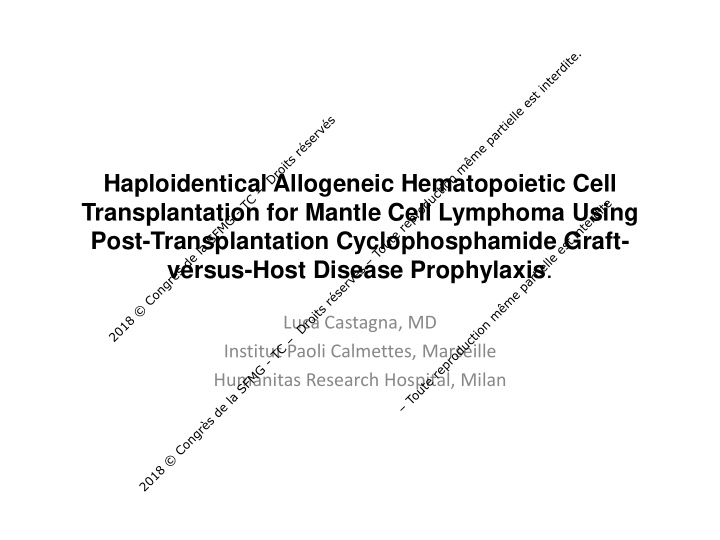



Haploidentical Allogeneic Hematopoietic Cell Transplantation for Mantle Cell Lymphoma Using Post-Transplantation Cyclophosphamide Graft- versus-Host Disease Prophylaxis . Luca Castagna, MD Institut Paoli Calmettes, Marseille Humanitas Research Hospital, Milan
Background • MCL patients who relapse after intensive first-line therapy have limited options to achieve durable disease control with conventional and novel therapies • Allogeneic stem cell transplantation can be an option
Background Authors N Disease status OS@3-5y PFS Relapse NRM Robinson 2002 22 CT S 73% 13% / 100% 82% Maris 2004 33 CT S 54% 64% 60% 16% 24% Armand 2008 15 / 42% 22% 33% 37% Tam 2009 35 CT S 83% 53% 46% / 9% Cook 2010 70 CT S 83% 37% 14% 65% 21% Hamadani 2013 202 Refractory 100% 25% 20% 33% 43% Kruger 2014 54 CT S 100% 73% 67% 15% 24% Mussetti 2015 29 CT S 90% 54% 41% 28% 29% Vaughn 2015 33 CT S 64% 55% 46% 26% 28% Tessoulin 2016 106 CT S 80% 62% 42% 24% 29% Robinson 2018 324 CT S 65% 40% 31% 40% 24% Median 53% (13-73) 42% (22-67) 28% (15-100 28% (9-82) MRD and UD donors
Background Campo, Blood 2015 Venetoclax Davids, JCO 2017
Robinson, Leukemia 2015
Allo-SCT program in lymphoma patients Marseille-Milan 308 2010-2017 40 14 HL 109 NHL 199 30 MUD 6 20 MRD HAPLO 20 10 DLBCL 60 MCL 40 0 ALLO SCT PTCL 60 FL 39
Patient characteristics N= 20 Median age (years, range) 65 (35-71) Disease risk Previous autologous 10 (50%) Previous allogeneic 1 (5%) Primary refractory disease 9 (45%) Disease status CR 15 (75%) PR 4 (20%) PD 1 (5%) HCT-C I 0-1 4 (20%) 2-3 12 (60%) 4-5 4 (20%) Donor relationship Offspring 17 (85%) Sibling 2 (10%) Parent 1 (5%) Conditioning regimen NMAC 16 (80%) RIC 4 (20%) CMV serostatus (D/R) neg/neg 6 (30%) neg/pos 4 (20%) pos/neg 3 (15%) pos/pos 7 (35%) Stem cells source PBSC 15 (75%) BM 5 (25%) Median follow up (months) 23 (5-73)
Results after haplo: GVHD • 100-day CI of aGVHD grade 2-4 was 35% (95% CI, 15% to 56%) • 2-year CI of moderate-severe cGVHD was 11% (95% CI, 2% to 30%)
Results after haplo: NRM 1.0 Cumulative incidence 0.8 0.6 0.4 3-y CI NRM: 16% (4-36) 0.2 0.0 0 200 400 600 800 1000 NRM.day
Results after haplo: relapse 1.0 0.8 Cumulative incidence 0.6 0.4 3y-CI relapse: 11% (2-29) 0.2 0.0 0 200 400 600 800 1000 Relapse.Day
Results after haplo: OS and PFS 1.0 1.0 3y-OS: 71% (43-77) 3y-PFS: 73% (47-88) 0.8 0.8 Probability Probability 0.6 0.6 0.4 0.4 0.2 0.2 0.0 0.0 0 200 400 600 800 1000 0 200 400 600 800 1000 Time.post.haplo PFS.day
Haplo vs MRD/MUD Haploidentical, n=20 MRD/UD, n=20 65 (35-71) Median age (years, range) 65 (35-71) Disease risk 10 (50%) Previous autologous 17 (85%) 1 (5%) Previous allogeneic / / Failure PBSC mobilization 1 (5%) 9 (45%) Primary refractory disease 2 (10%) Disease status 15 (75%) CR 17 (85%) 4 (4%) PR 2 (10%) 1 (5%) PD 1 (5%) Donor Sibling 6 (30%) MUD 14 (70%) 20 (100%) Haploidentical / Conditioning regimen 16 (80%) NMAC / 4 (20%) RIC 19 (95%) / MAC 1 (3%) Stem cells source 5 (25%) BM / 15 (75%) PBSC 20 (100%) 23 months (range 5-73) 63 months (range 26-93) Median follow up
Haplo vs MRD/MUD HAPLO MRD/UD 35% (15- 56) CI 100 day aGVHD grade 2-4 (95% CI) 45% (23-65) 11% (2-30) CI 2 years cGVHD (95% CI) 25% (9-45) 71% (43-77) 3 years OS (95% CI) 54% (30-73) 73% (47-88) 3 years PFS (95% CI) 54% (31-73) 11% (2-29) 3 years CI relapse (95% CI) 5% (0-21) 68% (42-84) 1 years GRFS (95% CI) 55% 31-73) 16% (4-36) 3 years NRM (95% CI) 41% (19-62)
Conclusions • Allo-SCT from haploidentical donor using PT Cy platform is active in patients with MCL. • The NRM and GVHD incidence are low • The relapse rate is low • However, this is a retrospective analysis with few patients
Recommend
More recommend